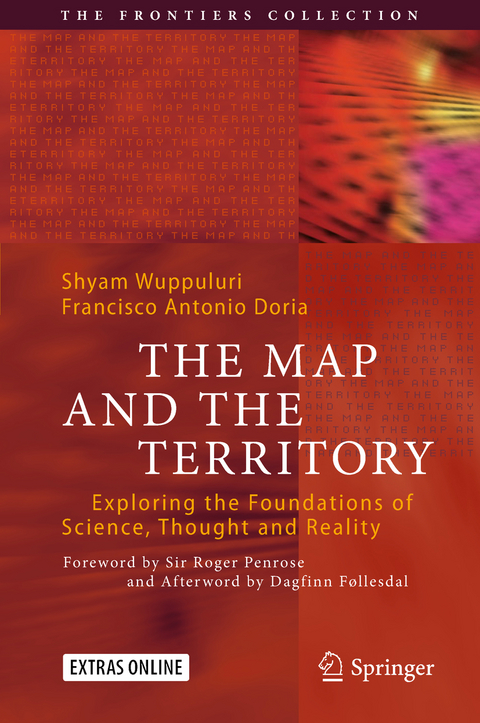
The Map and the Territory
Springer International Publishing (Verlag)
978-3-319-72477-5 (ISBN)
It is imperative to distinguish Map from the Territory while analyzing any subject but we often mistake map for the territory. Meaning for the Reference. Computational tool for what it computes. Representations are handy and tempting that we often end up committing the category error of over-marrying the representation with what is represented, so much so that the distinction between the former and the latter is lost. This error that has its roots in the pedagogy often generates a plethora of paradoxes/confusions which hinder the proper understanding of the subject. What are wave functions? Fields? Forces? Numbers? Sets? Classes? Operators? Functions? Alphabets and Sentences? Are they a part of our map (theory/representation)? Or do they actually belong to the territory (Reality)? Researcher, like a cartographer, clothes (or creates?) the reality by stitching multitudes of maps that simultaneously co-exist. A simple apple, for example, can be analyzed from several viewpoints beginning with evolution and biology, all the way down its microscopic quantum mechanical components. Is there a reality (or a real apple) out there apart from these maps? How do these various maps interact/intermingle with each other to produce a coherent reality that we interact with? Or do they not?
Does our brain uses its own internal maps to facilitate "physicist/mathematician" in us to construct the maps about the external territories in turn? If so, what is the nature of these internal maps? Are there meta-maps? Evolution definitely fences our perception and thereby our ability to construct maps, revealing to us only those aspects beneficial for our survival. But the question is, to what extent? Is there a way out of the metaphorical Platonic cave erected around us by the nature? While "Map is not the territory" as Alfred Korzybski remarked, join us in this journey to know more, while we inquire on the nature and the reality of the maps which try to map the reality out there.
The book also includes a foreword by Sir Roger Penrose and an afterword by Dagfinn Follesdal.
Shyam Wuppuluri is an independent researcher working in the domain of foundations of science. He is currently working as a research associate at R. N. Podar institute. His research interests range from philosophy to theoretical physics, mathematics and cognitive science. He is the recipient of Honra ao Merito from the Brazilian Academy of Philosophy (Academia Brasileira de Filosofia) and is also a corresponding member of the academy since 2018. He is also the recipient of prestigious Albert Einstein Fellowship 2020 from the Einstein Forum at Potsdam & Caputh. As a primary editor, he has edited various highly interdisciplinary volumes to disseminate and address the issues underlying the foundations of sciences by gathering world's leading scientists and intellectual leaders including Noam Chomsky, Sir Roger Penrose, Sir Martin Rees, Daniel Dennett, A. C. Grayling, Nicholas Humphrey, Gregory Chaitin, Gerard 't Hooft, Ian Stewart, Barry Mazur, Stephen Wolfram, Paul Davies, Tyler Burge, Doron Swade, Julian Barbour, Newton Da Costa, Francisco Antonio Doria, Reuben Hersh, Nicholas Maxwell and many others. Francisco Antonio Doria is a Brazilian physicist. Doria is a Professor Emeritus at the Federal University of Rio de Janeiro, where he currently teaches on the foundations of economic theory at the graduate School of Engineering (UFRJ COPPE). Doria has a B. Sc. in chemical engineering and a PhD in mathematical physics (under the guidance of Leopoldo Nachbin). He has made contributions to the gauge field copy problem in quantum field theory and proved with Newton da Costa several incompleteness theorems in mathematics, physics and mathematical economics, including the undecidability of chaos theory. Doria is a member of the Brazilian Academy of Philosophy, was a Senior Fulbright Scholar at Stanford University, 1989-1990, and a visiting researcher at the mathematics department, University of Rochester, 1979-1981. He thinks of himself as a philosopher and literary scholar with a humanist education, and has had as students Marcelo Gleiser and José Acacio de Barros, among other noted researchers. He likes to trace his interdisciplinary interests to a 17th century relative, the noted Portuguese writer Father Antonio Vieira (1608-1697).
Foreword by Sir Roger Penrose.- Preface to the Volume.- Acknowledgements.- Editors' Biographies.- Part I: Philosophy.- Part II: Theoretical Physics.- Part III: Mathematics/Computer Science.- Part IV: Biology/Cognitive Science.- Part V: Other Perspectives.- Afterword by Dagfinn Follesdal.
| Erscheinungsdatum | 03.03.2018 |
|---|---|
| Reihe/Serie | The Frontiers Collection |
| Zusatzinfo | XXIII, 641 p. 28 illus. |
| Verlagsort | Cham |
| Sprache | englisch |
| Maße | 155 x 235 mm |
| Gewicht | 1111 g |
| Themenwelt | Naturwissenschaften ► Physik / Astronomie ► Allgemeines / Lexika |
| Schlagworte | Descriptions of reality • Foundations of the scientific enterprise • Ontology of Operators • Ontology vs Epistemology • Philsophy of abstraction • Platonism and mathematical structures • Reality of Wavefunction |
| ISBN-10 | 3-319-72477-0 / 3319724770 |
| ISBN-13 | 978-3-319-72477-5 / 9783319724775 |
| Zustand | Neuware |
| Haben Sie eine Frage zum Produkt? |
aus dem Bereich


